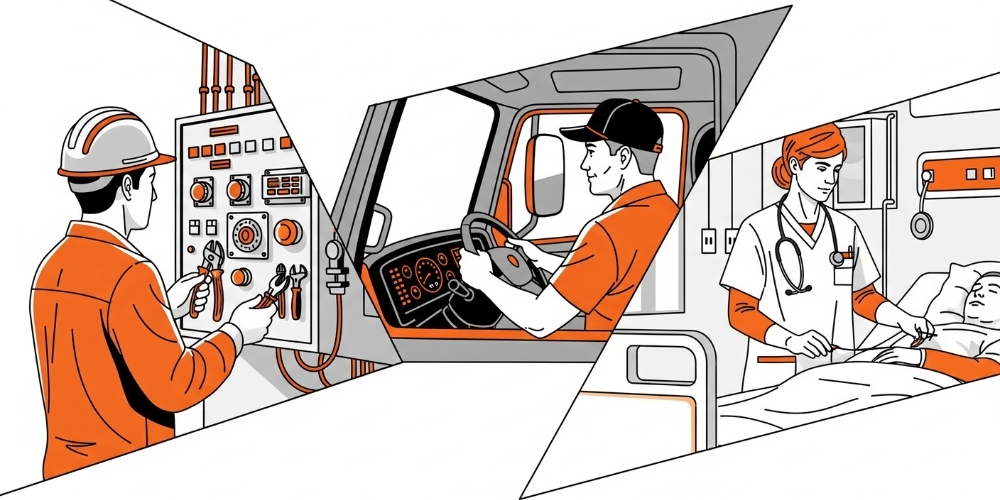GED vs High School Diploma: Which Gets You Hired Faster?

TL;DR
- GED vs high school diploma, both can land you entry-level jobs.
- Some employers prefer the high school diploma for its traditional path.
- The difference between GED and HS diploma is mainly in how they’re earned.
- Skills, training, and understanding AI hiring trends matter more than the credential.
Job seekers often wonder whether a GED vs high school diploma makes a difference when applying for jobs. The confusion is real because one’s a traditional path, the other a test-based alternative. Yet both are recognized credentials, so why do some employers seem to lean toward one over the other?
Both credentials can lead to a job offer, but your results depend on the industry, your additional skills, and how you market yourself. This blog will break down the difference between GED and HS diploma, compare hiring preferences, and show you how to make either one work in your favor using smart methods of recruitment and knowing how to prepare for a job interview.
GED vs High School Diploma — Quick Definitions

Before diving into the high school diploma vs GED debate, it helps to define each clearly.
High School Diploma
Awarded after completing a set number of courses over four years in grades 9–12, including math, science, English, and electives. The HS graduate meaning here is someone who has completed formal schooling as set by their state. For most employers, a diploma shows long-term commitment and exposure to teamwork, deadlines, and consistent assessment.
GED (General Educational Development)
A test-based credential that’s often called a high school equivalency diploma vs GED in some states. Passing the GED means you’ve shown academic knowledge equivalent to a graduate. It’s recognized in all 50 states, Canada, and internationally. The what is a GED equivalent answer is simple: it’s treated the same as a diploma in most hiring and college admissions processes.
Here’s where the what is the difference between GED and diploma comes in: a diploma is earned through years of coursework, while the GED is earned through four exams in Language Arts, Math, Science, and Social Studies. This is why the adult high school diploma vs GED question matters. Adults returning to education might choose the GED for speed or the diploma for structure.
People often ask why do people get their GED instead of a diploma and the reasons include dropping out due to personal circumstances, entering the workforce early, or pursuing a high school diploma alternative that fits their schedule.
You might even hear comparisons like GED vs GRE or GRE vs GED, but they’re entirely different. The GRE is a graduate school admissions test, while the GED is about high school-level completion.
And for those wondering what does GED diploma look like or how does the GED diploma look like, it’s a standard certificate with your name, date of completion, and official signatures, not much different from a diploma in appearance.
GED vs High School Diploma — Quick Definitions
How it’s earned: Self-paced study and testing.
Who it’s for: Adults or non-traditional students seeking a flexible option.
How it’s earned: Full-time study over 3–4 years.
Who it’s for: Traditional students following the standard academic path.
Key Differences Between GED and High School Diploma

While both credentials prove high school–level academic skills, the difference between GED and HS diploma comes down to time, structure, and perception.
1. Time to Earn
- High School Diploma – Usually takes four years of coursework. Students complete credits in core subjects and electives, along with extracurricular activities that help build soft skills.
- GED – Can be earned in a matter of months, depending on preparation time. You simply need to pass the four subject tests.
2. Learning Environment
- A diploma is tied to the traditional school system, meaning you’ll have in-person classes, homework, group projects, and exams spread over several years.
- The GED allows self-paced preparation, often online or through adult education programs, making it a preferred high school diploma alternative for working adults.
3. Skills Demonstration
- Diploma programs assess a range of academic and interpersonal skills over time.
- GED testing is focused on academic knowledge, not on long-term habits or participation.
4. Perception by Employers and Institutions
While many companies see them as equal, some employers view a diploma as evidence of persistence and social skill development. Certain industries, like skilled trades and service roles, show no hiring bias, but corporate or government positions may prefer a diploma.
5. Suitability for Adults
The adult high school diploma vs GED decision often depends on goals. Adults seeking a career change or college admission may find the GED faster. Those aiming for industries that value formal education pathways might prefer completing an adult HS diploma program.
Key Differences Between GED and High School Diploma
Drag each statement into the correct column.
GED
High School Diploma
Hiring Preferences — GED vs Diploma

The good news: both a GED and a diploma can open the door to employment. The less-good news: preferences vary by sector.
1. Sectors Where They’re Treated Equally
Many employers, especially in retail, hospitality, construction, and some tech support roles, accept a GED the same way they accept a diploma. In these sectors, skills and experience matter more than formal credentials. This answers part of the is a GED and a diploma the same thing question in hiring terms for these industries, yes.
2. Sectors That May Prefer a Diploma
Corporate, government, and administrative jobs may list a diploma as the baseline requirement, even though a GED technically matches it. Much of this comes down to perception. Some hiring managers think a diploma signals stronger preparation for structured workplaces. While that’s not always true, the why is a GED not as good as a diploma debate often stems from these biases.
3. Higher Education and Military Considerations
- College Admissions – In most U.S. colleges, a GED meets entry requirements, answering the what is a GED equivalent question in the education context.
- Military Service – You can enlist with a GED, but acceptance rates and job role availability may differ compared to diploma holders. According to the U.S. Army, GED holders fall into a separate enlistment tier, and meeting ASVAB score requirements becomes more crucial.
4. Impact of AI in Screening
Modern recruitment often uses AI-powered systems that scan resumes before a human sees them. These systems don’t “prefer” one credential over the other but the way you present it matters. Knowing how do you put GED on resume correctly (e.g., “High School Equivalency Diploma, GED, [Year]”) ensures you pass initial screening in line with AI hiring trends.
Hiring Preferences — GED vs Diploma
Choose the applicant you would interview first.
Applicant A — GED
Earned GED last year. 1 year retail experience. Recently completed customer service training.
Applicant B — High School Diploma
Diploma graduate. 2 years admin assistant experience. Strong references from previous employer.
Applicant C — Diploma + Certifications
Diploma graduate with IT support certification. 1 year tech help desk experience.
Which Gets You Hired Faster?

The honest answer: neither is automatically faster. It depends on your field, location, and career readiness.
When a GED Might Get You Working Sooner
- If you’re an adult without a diploma, passing the GED can take as little as a few weeks or months of preparation. This makes it a quick high school diploma alternative for entering fields like warehouse operations, food service, and certain skilled trades.
- In industries facing labor shortages like trucking, manufacturing, or some healthcare support roles, a GED holder can be hired just as fast as someone with a diploma.
When a Diploma Might Give You an Edge
- Jobs in corporate settings, government roles, and apprenticeships sometimes process diploma holders faster because hiring teams are more familiar with the credential.
- In competitive regions where supply outweighs demand, employers might choose applicants with traditional schooling simply due to perceived commitment.
Why Neither Credential Works Alone
Getting hired quickly is less about GED vs high school diploma and more about the total package, such as resume strength, skills, interview performance, and networking. Pairing either credential with certifications, internships, or industry-recognized training makes a bigger impact on time-to-hire than the credential alone.
According to the U.S. Bureau of Labor Statistics, workers with at least a high school–level education have median weekly earnings of $853 compared to $682 for those without. That applies to both GED and diploma holders.
Which Gets You Hired Faster?
How to Improve Your Job Prospects With Either Credential

Whether you hold a GED vs high school diploma, your success depends on how you build on it. Here’s how to make either credential work harder for you:
1. Add Industry Certifications
Employers value job-ready skills. Pair your credentials with certifications in areas like IT support, healthcare assistance, bookkeeping, or trades. Free or low-cost training is available through platforms like Coursera.
2. Use Smart Job Search Strategies
Leverage modern methods of recruitment, including online job boards, industry-specific forums, and community hiring events. Use LinkedIn and local networking groups to meet recruiters directly.
3. Build a Strong Resume
If you earned a GED, learn how do you put GED on resume so it reads clearly:
High School Equivalency Diploma (GED) – [State], [Year]
Avoid leaving it vague because clear wording passes both human review and ATS filters tied to AI hiring trends.
4. Prepare for Interviews
Know how to prepare for a job interview. Practice answering behavioral questions, research the company, and have stories ready that demonstrate teamwork, problem-solving, and initiative.
5. Gain Work Experience Quickly
Internships, part-time jobs, or volunteer work can close gaps and show employers you take initiative.
6. Keep Learning
You can keep building your skills in many ways, such as from community college classes to trade programs or even online courses. Employers see this as a sign you’re serious about growing and able to adapt to new challenges.
Best Jobs for GED Holders

You still have access to many careers that pay well and offer steady work, if you have a GED. These are some good choices:
1. Skilled Trades
Jobs like electrician, plumber, or HVAC technician typically require trade school or apprenticeships, not a diploma. The demand for these roles remains high across the U.S., with many offering paid training.
2. Healthcare Support Roles
Jobs like Certified Nursing Assistant (CNA) or Medical Assistant are open to those with a GED, as long as you complete a short training program or certification. According to the U.S. Department of Labor, healthcare support roles are projected to grow faster than average through 2033.
3. Transportation and Logistics
Truck drivers, delivery drivers, and warehouse supervisors often start with a GED and CDL or other on-the-job training.
4. Manufacturing and Production
Assembly line work, machine operation, and quality inspection jobs often accept GED holders, especially in regions with strong manufacturing sectors.
5. Security and Protective Services
Security guards, correctional officers, and similar roles may require only a GED, background check, and basic training.
6. Sales and Customer Service
In roles from retail to call centers, employers usually care more about communication skills and dependability than the exact type of high school credential.
Best Jobs for GED Holders
Electrician
Average Salary: $60,000/year
💡 Tip: Certification and apprenticeship programs can boost earnings.
Certified Nursing Assistant (CNA)
Average Salary: $36,000/year
💡 Tip: Specializing in certain healthcare areas can open more job options.
Truck Driver
Average Salary: $48,000/year
💡 Tip: Earning additional safety and route certifications can increase pay.
HVAC Technician
Average Salary: $50,000/year
💡 Tip: Off-season training keeps skills sharp and competitive.
Best Jobs for High School Diploma Holders

Having a high school diploma can help you get into fields that value a standard educational background. For example:
1. Administrative Support
Roles like office assistant, receptionist, or data entry clerk often ask for a diploma. Employers see these jobs as needing dependable, organized, and consistent work habits.
2. Government and Public Sector Jobs
Some clerical or entry-level agency positions list “diploma or equivalent” but may favor diploma holders when competition is high.
3. Skilled Apprenticeships
Programs in trades like carpentry, welding, and advanced manufacturing sometimes recruit directly from high schools, giving diploma holders a head start.
4. Hospitality Management Tracks
Hotel front desk supervisors, event coordinators, and shift managers may prefer diploma holders with strong math and customer service backgrounds.
5. Law Enforcement Entry Roles
While some departments accept GEDs, many recruit directly from high school graduates for police cadet or community service officer programs.
6. Banking and Financial Services
Teller and customer service roles in banks often require a diploma, especially in markets where competition for entry roles is higher.
Best Jobs for High School Diploma Holders — Career Path Flowchart
Office Work
Hands-On Work
Service-Oriented Work
Conclusion
When it comes to GED vs high school diploma, both credentials can open doors, but the speed at which you get hired depends more on your skills, preparation, and job search strategy than on the credential itself. A GED can be the quicker path for adults re-entering education, while a diploma might offer more familiarity to employers in certain fields.
The key is to pair whichever you have with practical skills, relevant certifications, and a strong approach to job hunting. Whether you’re pursuing your first role or aiming for career growth, combining your credentials with smart methods of recruitment and knowing how to prepare for a job interview will put you ahead of many applicants.
FAQs
Is a GED accepted for college admissions?
Yes. Most U.S. colleges and universities accept a GED as equivalent to a high school diploma. Admissions teams will also look at placement tests, SAT/ACT scores or previous coursework. So, make sure to highlight any additional academic or professional achievements.
Can you join the military with a GED?
Yes, but it can be more competitive. The military accepts GED holders, but you may fall into a different enlistment tier, which means you might need higher ASVAB scores or additional college credits before certain roles are available.
Which is harder: getting a GED or a high school diploma?
It depends on your situation. A diploma requires years of consistent coursework and participation, while the GED is condensed into four subject tests that require strong study skills. For some, the long-term commitment of a diploma feels harder; for others, passing all GED exams in a short timeframe is more challenging.
Do employers really care if you have a GED instead of a diploma?
In many industries, no. Employers often value experience, skills and reliability over the exact type of credential. However, in competitive fields or for certain corporate and government positions, a diploma might be preferred simply because it’s the more familiar path.






